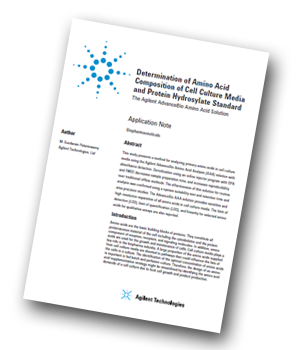Agilent Technologies has produced an application note describing a study presenting a method for analysing primary amino acids in cell culture media that decreases sample preparation time and increases reproducibility.
 Abstract
Abstract
This study presents a method for analysing primary amino acids in cell culture media using the Agilent AdvanceBio Amino Acid Analysis (AAA) solution with absorbance detection. Derivitization using an online injector program with OPA and FMOC decreases sample preparation time, and increases reproducibility over traditional offline methods. The effectiveness of this solution for routine analysis was confirmed using a system suitability test and retention time and area precision studies. The AdvanceBio AAA solution provides sensitive and high‑resolution separation of all amino acids in cell culture media. The limit of detection (LOD), limit of quantification (LOQ), and linearity for selected amino acids for qualitative assays are also reported.
Introduction
Amino acids are the basic building blocks of proteins. They constitute all proteinaceous material of the cell including the cytoskeleton and the protein component of enzymes, receptors, and signaling molecules. In addition, amino acids are used for the growth and maintenance of cells. Cell culture media plays a key role in the biopharma industry. A large proportion of the amino acids supplied from cell culture media are diverted to pathways that could influence the fate of the cells in a culture. The identification of the optimal concentration of amino acids is important in fed batch and perfusion culture. Therefore, the design of an amino acid supplementation strategy might be streamlined by identifying the amino acid demands of a cell culture due to host cell growth and product production.
Instrumentation
Analyses were performed using an Agilent 1290 Infinity LC, which was equipped with an Agilent 1290 Infinity binary pump delivery system (G4220A), Agilent 1290 Infinity autosampler (G4226A), Agilent 1290 Infinity thermostatted column compartment (G1316C), and Agilent 1290 Infinity DAD (G4212A).
Results and Discussion
High-throughput routine analysis The chromatogram shown in Figure 1 illustrates the standard analytical sensitivity achieved in high-throughput separations of amino acids. This chromatogram was obtained using an Agilent 1290 Infinity LC with an Agilent AdvanceBio AAA, 4.6 × 100 mm, 2.7 μm column using the amino acid method with DAD detection. A single run was completed in 18 minutes (including re-equilibration) with adequate resolution. The primary amino acids (1-20, OPA-derivatized), shown in this figure, were monitored at 338 nm, while the secondary amino acids (21-23, FMOC-derivatized) were monitored at 262 nm.
The chromatogram shown in Figure 1 illustrates the standard analytical sensitivity achieved in high-throughput separations of amino acids. This chromatogram was obtained using an Agilent 1290 Infinity LC with an Agilent AdvanceBio AAA, 4.6 × 100 mm, 2.7 μm column using the amino acid method with DAD detection. A single run was completed in 18 minutes (including re-equilibration) with adequate resolution. The primary amino acids (1-20, OPA-derivatized), shown in this figure, were monitored at 338 nm, while the secondary amino acids (21-23, FMOC-derivatized) were monitored at 262 nm.
Conclusion
This application note demonstrates several Agilent tools for the analysis of amino acids. The Agilent 1290 Infinity LC and the Agilent AdvanceBio AAA kit were used for the automated online derivatization of amino acids using OPA/FMOC chemistries. The derivitized amino acids were then separated on an AdvanceBio AAA LC column to achieve a fast, sensitive, and reproducible separation of amino acids. Area and RT precision of the method were excellent, and met the system suitability requirement. Linearity curves with 10 standard concentrations of three amino acids, ranging from 0.9 pmol to 1 nmol, had excellent coefficient of linearity values, indicating that the method was quantitative and accurate. The LOD and LOQ for the amino acids were 0.9 pmol and 3.8 pmol, respectively, indicating that the method was sensitive. In addition, this method was able to separate and detect amino acids from cell culture media and protein hydrolysate standard. The amino acid composition determined using this method correlated well with their theoretical compositions.




